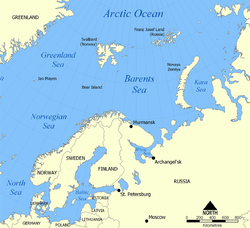This article includes a list of general references, but it lacks sufficient corresponding inline citations .(February 2012) |
| Convoy JW 51B | |||||||
|---|---|---|---|---|---|---|---|
| Part of the Second World War | |||||||
 The Norwegian and the Barents seas, site of the Arctic convoys | |||||||
| |||||||
| Belligerents | |||||||
| Commanders and leaders | |||||||
| |||||||
| Strength | |||||||
|
| ||||||
| Casualties and losses | |||||||
|
| ||||||
Convoy JW 51B was an Arctic convoy sent from United Kingdom by the Western Allies to aid the Soviet Union during the Second World War. It sailed in late December 1942, reaching the Soviet northern ports in early January 1943.
Contents
- Background
- Convoy escorts
- German forces
- Prelude
- Action
- Aftermath
- Analysis
- Allied order of battle
- Merchant ships
- Western escort
- Close escort
- Ocean escort
- Force R
- Distant cover
- Allied submarines
- German order of battle
- U-boats
- Surface force
- Footnotes
- References
- Further reading
- External links
Convoy JW 51B came under attack by German surface units, engaged in Operation Regenbogen, on 31 December. In the engagement, a British minesweeper and a British destroyer were sunk and a German destroyer were sunk; no ships were lost from the convoy in what became known as the Battle of the Barents Sea.